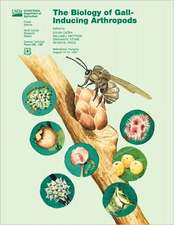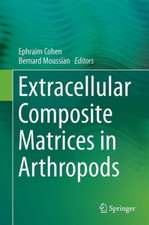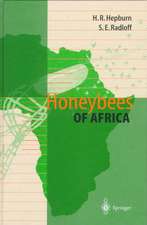Saproxylic Insects: Diversity, Ecology and Conservation: Zoological Monographs, cartea 1
Editat de Michael D. Ulyshenen Limba Engleză Hardback – 31 mai 2018
The book is divided into four parts:
· Part I “Diversity” includes chapters addressing the major orders of saproxylic insects (Coleoptera, Diptera, Hymenoptera, Hemiptera, Lepidoptera and Blattodea), broadly organized in decreasing order of estimated global saproxylic diversity. In addition to order-level treatments, some chapters in this part discuss groups of particular interest, including pollinators, hymenopteran parasitoids, ants, stag and passalid beetles, and wood-feeding termites.
· Part II “Ecology” discusses insect-fungal and insect-insect interactions, nutritional ecology, dispersal, seasonality, and vertical stratification.
· Part III “Conservation” focuses on the importance of primary forests for saproxylic insects, offers recommendations for conserving these organisms in managed forests, discusses the relationships between saproxylic insects and fire, and addresses the value of tree hollows and highly-decomposed wood for saproxylic insects. Utilization of non-native wood by saproxylic insects and the suitability of urban environments for these organisms are also covered.
· Lastly, Part IV “Methodological Advancements” highlights molecular tools for assessing saproxylic diversity.
The book offers an accessible and insightful resource for natural historians of all kinds and will especially appeal to entomologists, ecologists, conservationists and foresters.
| Toate formatele și edițiile | Preț | Express |
|---|---|---|
| Paperback (1) | 2117.26 lei 6-8 săpt. | |
| Springer International Publishing – 30 ian 2019 | 2117.26 lei 6-8 săpt. | |
| Hardback (1) | 2123.91 lei 6-8 săpt. | |
| Springer International Publishing – 31 mai 2018 | 2123.91 lei 6-8 săpt. |
Preț: 2123.91 lei
Preț vechi: 2590.13 lei
-18% Nou
Puncte Express: 3186
Preț estimativ în valută:
406.40€ • 425.46$ • 336.28£
406.40€ • 425.46$ • 336.28£
Carte tipărită la comandă
Livrare economică 05-19 aprilie
Preluare comenzi: 021 569.72.76
Specificații
ISBN-13: 9783319759364
ISBN-10: 3319759361
Pagini: 500
Ilustrații: IX, 904 p. 111 illus., 88 illus. in color.
Dimensiuni: 155 x 235 mm
Greutate: 1.45 kg
Ediția:1st ed. 2018
Editura: Springer International Publishing
Colecția Springer
Seria Zoological Monographs
Locul publicării:Cham, Switzerland
ISBN-10: 3319759361
Pagini: 500
Ilustrații: IX, 904 p. 111 illus., 88 illus. in color.
Dimensiuni: 155 x 235 mm
Greutate: 1.45 kg
Ediția:1st ed. 2018
Editura: Springer International Publishing
Colecția Springer
Seria Zoological Monographs
Locul publicării:Cham, Switzerland
Cuprins
An introduction to the diversity, ecology and conservation of saproxylic insects.- General overview of saproxylic Coleoptera.- Ecology and conservation of Passalidae.- Diversity and ecology of stag beetles (Lucanidae).- Saproxylic Diptera.- Ecology, diversity and conservation of saproxylic hymenopteran parasitoids.- Saproxylic bees and wasps.- Ants: Ecology and impacts in dead wood.- Diversity and ecology of saproxylic Hemiptera.- Diversity of saproxylic Lepidoptera.- Wood-feeding termites.- Insect-fungus interactions in dead wood systems.- Nutrient dynamics in decomposing dead wood in the context of wood eater requirements: The ecological stoichiometry of saproxylophagous insects.- Biotic interactions between saproxylic insect species.- Dispersal of saproxylic insects.- Seasonality and stratification: Neotropical saproxylic beetles respond to a heat and moisture continuum with conservatism and plasticity.- Importance of primary forests for the conservation of saproxylic insects.- The importance of dead-wood amount for saproxylic insects and how it interacts with dead-wood diversity and other habitat factors.- Conservation of saproxylic insect diversity under variable retention harvesting.- Saproxylic insects and fire.- Saproxylic insects in tree hollows.- It's the end of the wood as we know it: Insects in veteris (highly-decomposed) wood.- Utilization of non-native wood by saproxylic insects.- The role of urban environments for saproxylic insects.- Molecular tools for assessing saproxylic insect diversity.
Notă biografică
Michael D. Ulyshen
Research Entomologist
USDA Forest Service
Southern Research Station
320 Green Street
Athens, Georgia 30602, USA
E-mail: mulyshen@fs.fed.us
Phone: 706-559-4296
Research Entomologist
USDA Forest Service
Southern Research Station
320 Green Street
Athens, Georgia 30602, USA
E-mail: mulyshen@fs.fed.us
Phone: 706-559-4296
Textul de pe ultima copertă
This volume offers extensive information on insect life in dying and dead wood. Written and reviewed by leading experts from around the world, the twenty-five chapters included here provide the most global coverage possible and specifically address less-studied taxa and topics. An overarching goal of this work is to unite literature that has become fragmented along taxonomic and geographic lines. A particular effort was made to recognize the dominant roles that social insects (e.g., termites, ants and passalid beetles) play in saproxylic assemblages in many parts of the world without overlooking the non-social members of these communities.
The book is divided into four parts:
- Part I “Diversity” includes chapters addressing the major orders of saproxylic insects (Coleoptera, Diptera, Hymenoptera, Hemiptera, Lepidoptera and Blattodea), broadly organized in decreasing order of estimated global saproxylic diversity. In addition to order-level treatments, some chapters in thispart discuss groups of particular interest, including pollinators, hymenopteran parasitoids, ants, stag and passalid beetles, and wood-feeding termites.
- Part II “Ecology” discusses insect-fungal and insect-insect interactions, nutritional ecology, dispersal, seasonality, and vertical stratification.
- Part III “Conservation” focuses on the importance of primary forests for saproxylic insects, offers recommendations for conserving these organisms in managed forests, discusses the relationships between saproxylic insects and fire, and addresses the value of tree hollows and highly-decomposed wood for saproxylic insects. Utilization of non-native wood by saproxylic insects and the suitability of urban environments for these organisms are also covered.
- Lastly, Part IV “Methodological Advancements” highlights molecular tools for assessing saproxylic diversity.
Caracteristici
Incorporates information from tropical and subtropical forests Recognizes the key roles that social insects play in saproxylic assemblages Highlights some of the less commonly studied taxa Addresses the value of highly decomposed wood Provides a global and holistic understanding of saproxylic insects, including their diversity, ecology and vulnerability to ongoing and emerging threats



















